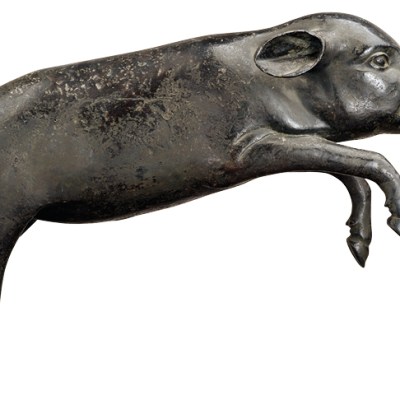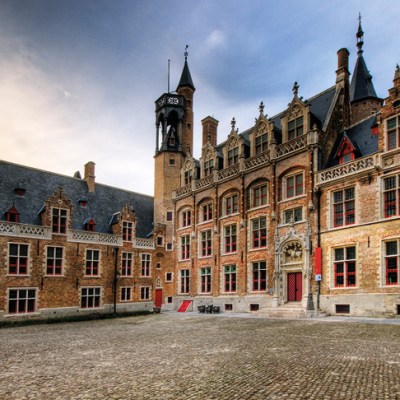On 1 June 1485, Frederick III, Holy Roman Emperor and head of the house of Habsburg was, for the second time in his life, in retreat from Vienna. The city that in centuries to come would be indelibly associated with the name of his dynasty had fallen to a Hungarian army led by a far superior commander. For five years thereafter, Emperor Frederick, successor to Caesar and Augustus, Charlemagne and Barbarossa, lived a peripatetic life. His favourite motto, Alles Erdreich ist Österreich untertan (‘All the world is subject to Austria’), at the best of times a statement of wild ambition, was now a bleak parody of his situation.
Worse was to come. In 1477, Frederick’s eldest son, Maximilian (1459–1519), had married Mary, Duchess of Burgundy, heir to one of Europe’s richest realms, spread across northern France and the Low Countries. But Mary’s death in a hunting accident five years later soured things. Maximilian remained in the duchy as regent for their infant son, Philip, but in 1488, the citizens of Bruges rose up against him. Maximilian was captured, imprisoned and threatened with execution. In despair, he was forced to forswear control of the duchy that he had once likened to a rose garden.
For the rest of his life, Maximilian – who died in 1519, 500 years ago – lived in the shadow of this double humiliation, dynastic and personal. In time, the Habsburgs were restored to their hereditary Austrian estates: the Hungarians were expelled from Vienna in 1490. In the same year Maximilian added the silver-rich county of Tyrol to his patrimony. Following Frederick’s death in 1493, Maximilian succeeded him as ruler of the Holy Roman Empire with little resistance, though tradition dictated that he could not officially assume the title of emperor unless crowned by the pope in Rome.
Even so, he could never live down the yawning disparity between his illustrious office and the reality of his circumstances. Secure in his own lands he might have been after 1490, but he was never as wealthy, as triumphant on the battlefield, as successful in his diplomacy or as all-conquering with women as his father’s ubiquitous motto had from childhood led him to think he should be. As setback mounted on setback – repudiation by Anne of Brittany, to whom he was betrothed, in 1491, trouncing by the Swiss in 1499, the death of his son Philip in 1506, repeated defeats in northern Italy at the hands of the French, the thwarting of his plans to travel to Rome for coronation as emperor – Maximilian assembled an army of artists, poets, craftsmen, scholars, printers and engineers to conjure up an alternative universe in which Austria and its ruling house carried all before them. He fought more than 20 wars, yet never substantially managed to extend Austria’s territorial boundaries or cement his authority in Germany. But his dreams, or delusions, were nearly boundless. Following the death in 1510 of his second wife, Bianca Maria Sforza, he fantasised about becoming pope, resolving never again to ‘pursue naked women’, and ‘afterwards a saint, so that after my death you will have to worship me, of which I shall be very proud’.

The image of Maximilian most familiar today – that of Dürer’s portrait of 1519 – is perhaps the least typical. Dressed in a fur mantle and broad-brimmed cap and cradling a pomegranate in his left hand, Maximilian might easily be mistaken for one of the burghers of Nuremberg who provided Dürer with such regular commissions. The only clues to his high status are the small coat of arms in the top left-hand corner and a Latin recitation of his titles. Completed as Maximilian was nearing death (or perhaps even after his demise), it is uncharacteristically understated. Modesty, reticence, discretion – these were not values that were especially dear to his heart. The painting seems to have escaped the close scrutiny to which Maximilian routinely subjected the works he had commissioned, but one can perhaps anticipate his feelings about it from the response of his daughter, Archduchess Margaret, when Dürer offered it to her in 1520–21. ‘Since she disliked it so much,’ the painter noted in his journal, ‘I took it away again.’
Dürer’s portrait is untypical in another sense too. Of all the mediums available to artists at the turn of the 16th century, oil painting was one of those that Maximilian valued least. He was no lover of art for its own sake. The masters of the Italian Renaissance held little appeal for him and he never sought to emulate the Medicis or the Estes in creating a collection of virtuosic paintings. Without a fixed capital – ‘my true home is in the stirrup, the overnight rest and the saddle’, he declared – he would in any case have had few opportunities to display and appreciate such a collection.
For Maximilian, art had one function: to glorify himself and his dynasty. For this reason, he privileged forms that could reach as wide an audience as possible across the Holy Roman Empire – coins and medals, murals and, supremely, printed works – above those that were by nature private, exclusive or immovable. His popular reputation in the centuries after his death as the ‘last knight’ can obscure the enthusiasm with which he embraced new technologies. He might have been in thrall to medieval Heldenbücher (‘hero books’, or manuscripts containing tales of knightly exploits) but he was also ruthless in exploiting the printing press to present himself to the world.
When it came to the subjects of the works he commissioned, Maximilian’s approach was similarly partial. The only matters worthy of artistic attention were his family, his territories and, of course, himself. Although he is sometimes styled as a Renaissance prince, classical mythology never seems to have fired his enthusiasm. The new learning impinged on his consciousness only as far as it served his desire to fashion himself as a latter-day Roman emperor (Rome, he liked to declare, was ‘the former seat of our throne’). In pedigrees he had himself portrayed as a descendant of Hector and Aeneas, and he also encouraged the scholar Conrad Peutinger to produce facsimiles of ancient Roman inscriptions found in Germany. But his interest in the classical past did not extend beyond efforts to connect the Roman Empire with his own realm. Devotional art was also largely absent from his patronage, except when the object of devotion was his own dynasty – see, for instance, the Altar of St George of c. 1516–19 at Ambras Castle, the side panels of which display portraits of his grandsons Charles and Ferdinand respectively disguised as St Agathius and St Sebastian.

Wolf Traut. National Gallery of Art, Washington, D.C.
Size also mattered. Larger works had the double advantage of emphasising Maximilian’s grandeur and of being visible to a great number of people. Moreover, it was only on a vast, almost megalomaniacal scale, that Maximilian felt able to incorporate all the elements – genealogy, chivalry, piety, wisdom, virtue, abundance, military valour – intrinsic to his self-perception as ruler. The Triumphal Procession of Maximilian I, a woodcut frieze modelled on a Roman triumph climaxing with Maximilian in a sumptuous chariot, contained some 135 separate images and measured over 50 metres in length. In the same category is Arch of Honour, a 195-block woodcut mural of a fantastical ceremonial gateway erected in tribute to Maximilian.
And yet, contrary to the impression they were supposed to convey, such works were cheap, at least in comparison to the real-life equivalents of what they depicted. Once the woodblocks had been made, there was no end to the number of times they could be reused. For the impecunious Maximilian, a hundred copies of Arch of Honour pasted on the walls of German city halls represented better value than a single real arch (or, more realistically, a permanent building site) in one of the little-visited Austrian cities that he ruled.
Maximilian’s preference for mobile, duplicable works over individual masterpieces has proved a boon for curators in this quincentennial year. The Österreichische Nationalbibliothek in Vienna and the Hofburg in Innsbruck have organised impressive exhibitions (‘Emperor Maximilian I: A Great Habsburg’, until 3 November; ‘Maximilian I and the Rise of the Modern World’, until 12 October), while a number of other institutions across the German-speaking world have mounted smaller ones. A further substantial exhibition is due to open at the Metropolitan Museum in New York (‘The Last Knight: The Art, Armor, and Ambition of Maximilian I’; 7 October–5 January 2020). Five hundred years too late it may be, but this international commemorative extravaganza has gone some way towards vindicating Maximilian’s strategy.
When Maximilian was born in 1459, the Habsburgs were a dynasty on the make. Maximilian’s father, Frederick, was the first member of the house to be crowned Holy Roman Emperor, an office that gave its holder sovereignty over Germany (though in practice its powers were severely circumscribed). The Habsburgs were at this time very much an Austrian dynasty – the thought that representatives of the family would one day not only fill the thrones of Spain, Portugal, Hungary and Bohemia but also hold sway over a still-undiscovered continent on the other side of the world was then beyond the wildest imaginings of even someone as prone to fantasy as Maximilian. Moreover, the lack of a royal crown – they had to make do with the invented honour of archduke – rankled with them. For Maximilian, it made retention of the imperial title an overriding obsession.
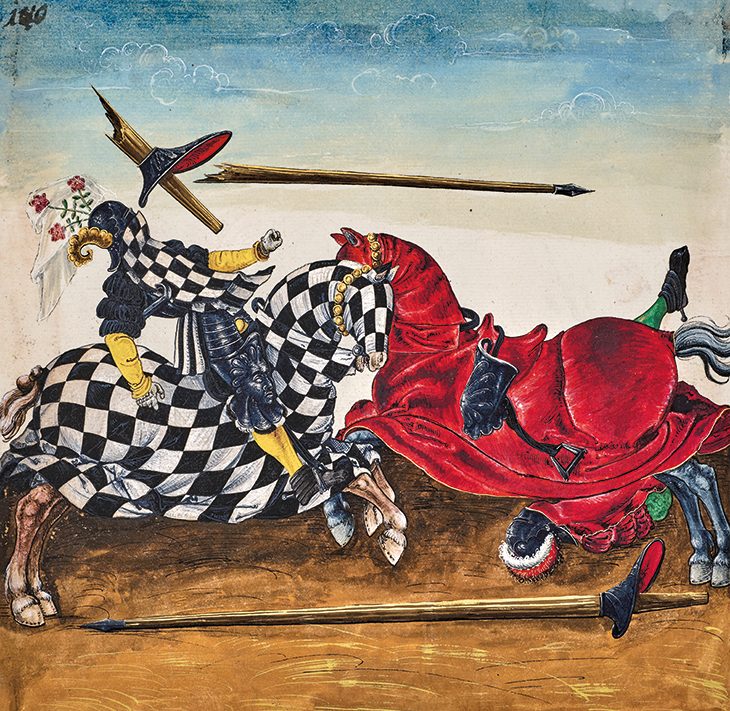
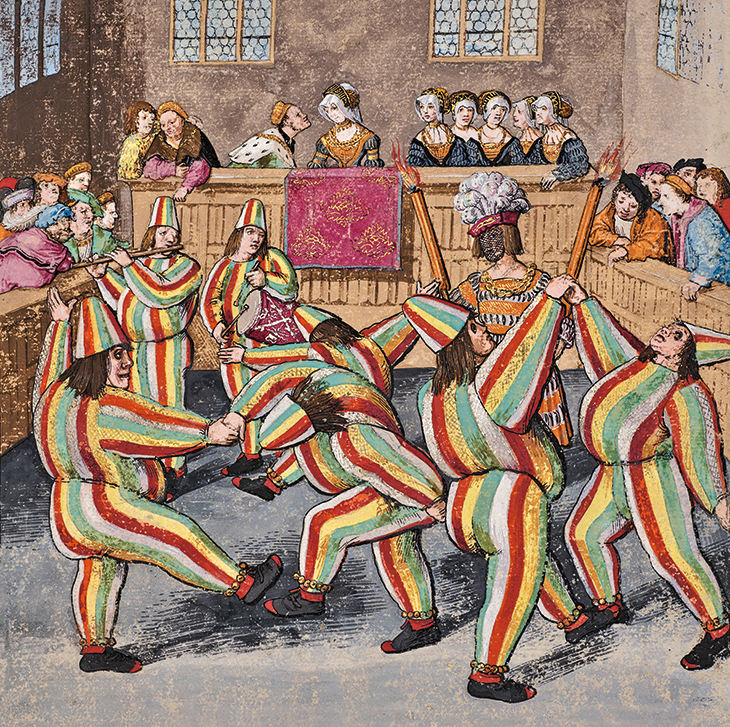
Maximilian’s marriage in 1477 to Mary, daughter of Charles the Bold, Duke of Burgundy, marked a step up for the dynasty. Although the house of Burgundy had no crown to boast of, its court was renowned throughout Europe as a centre of artistic brilliance and chivalric prowess. For Maximilian, who had been brought up in the cultural backwoods of Wiener Neustadt by a cold and philistine father, the court of Burgundy was like a vision in the desert. The decade and a half he spent in the Low Countries left him with an abiding love of the tournament and its attendant ceremony. It inspired some of his most exuberant works, most notably Freydal, a 256-image illustrated manuscript created in around 1512 depicting the tournaments in which Maximilian had competed, along with the wassails that followed (the 255 manuscript miniatures that survive, in the collection of the Kunsthistorisches Museum in Vienna, have been reproduced this year in a grand volume published by Taschen). It also motivated the commissioning of magnificent suits of armour from Lorenz Helmschmid in Augsburg and Conrad Seusenhofer in Innsbruck. Maximilian was not satisfied with being emperor alone. The perfect prince also had to be the perfect knight.
Maximilian’s artistic patronage began in earnest after his final departure from the Low Countries in 1493, when the brilliance of the Burgundian court was passing from reality into memory. It accelerated in the last decade of his life, as his thoughts were turning to his death and legacy. By then, it had become clear that he would never make it to Rome to be crowned in person by the pope – he had to make do with having himself declared ‘Holy Roman Emperor elect’ in Trento in 1508. The death of his son and heir, Philip, in 1506 provided an additional creative impetus. Thereafter, hopes of his dynasty rested on his two infant grandsons, the eldest of whom, Charles, was in line to succeed to the throne of Spain. For Maximilian, the prospect of universal monarchy was beginning to seem tantalisingly within reach, but it would come to nothing if the house of Habsburg could not retain the imperial crown and consolidate its position in Germany.
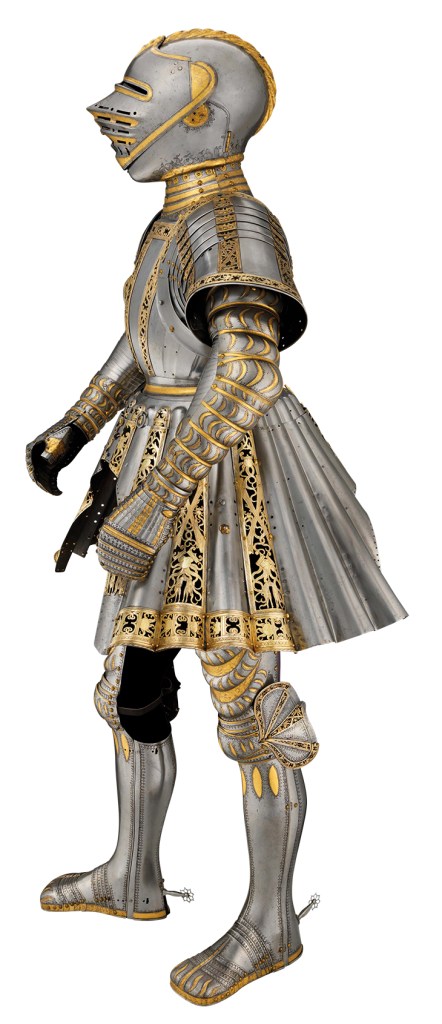
Although the court of Burgundy remained nonpareil in Maximilian’s mind, conditions in Austria prevented him from ever emulating it, at least physically. For one, Maximilian’s ordinary income was a fraction of what the rulers of the Low Countries received. Maximilian was sustained for most of his reign by loans the Fugger banking house, topped up by the dowry of his unloved second wife Bianca Maria Sforza – his debts at the end of his life amounted to six million guilders, around 20 times the annual revenues of his hereditary Austrian lands. Moreover, as sovereign of Germany and self-styled defender of the Holy Roman Empire, Maximilian was forever on the move, resisting French expansionism in the west and Italy, trying to quell revolts among the Swiss, mustering support for a crusade against the Turks and begging for money from the imperial diet at Worms, Trier or wherever else it had assembled. It was impossible to create a single capital.
His itinerancy affected his artistic patronage in other ways too. For most of his life, Maximilian maintained a court painter, Jörg Kölderer, to fulfil limited commissions, such as banner-painting and manuscript illumination. For larger projects, however, he relied on artist-contractors based not at court but in the cities of southern Germany. The most notable of these were Dürer and his workshop in Nuremberg, Albrecht Altdorfer and his school in Regensburg and the circle of artists around Hans Burgkmair in Augsburg. The sheer scale of some of Maximilian’s ventures meant that multiple artists and craftsmen in different places were often engaged on a single project. Supervision was undertaken by Maximilian’s agents in these cities, who communicated with him via his secretary Marx Treitzsaurwein and others who accompanied him on his travels.
The closest Maximilian had to a permanent residence was Innsbruck, conveniently positioned between Germany and Italy, near to the silver mines of Schwaz and surrounded by forested mountains, where Maximilian could indulge his love of the chase. But even there he lived modestly, his residence – brilliantly recreated in digital form as part of the exhibition at the Innsbruck Hofburg from three sketches by Dürer – a jumble of ramparts, turrets and courtyards inherited from his cousin Sigismund. Maximilian’s two principal contributions to this ensemble were the Armorial Tower, a gateway festooned with the coats of arms of his dominions, and the Golden Roof (Goldenes Dachl), an Italian-style loggia crowned with golden tiles of fire-gilded copper and decorated with reliefs depicting his marriages.
The programmatic nature of Maximilian’s two principal embellishments to the Innsbruck Hofburg is characteristic of his artistic commissions at large. Art in Maximilian’s world was indistinguishable from propaganda. A number of themes were accentuated and continually reiterated – Maximilian’s physical accomplishments, the nobility of his ancestry, the virtuous character of his rule, his brilliance on the tournament field, the richness of his lands – sometimes individually, sometimes in combination with each other.
The most complex of Maximilian’s schemes, Arch of Honour and Triumphal Procession, united almost all his preoccupations. The first of these was devised by Kölderer and the scholar Johannes Stabius and designed by Dürer, Altdorfer and others. First printed in 1517–18 (dated 1515), it depicts a gateway of Babylonian proportions with three separate archways, resembling more a Hindu temple than a Roman monument. Maximilian sits in a godlike position at the top of the central column, amid a melee of images. Around him are gathered saints, Roman emperors, genuine and fictional ancestors, crowns, armorial shields, images of his triumphs, scenes from his domestic life and symbols of the cardinal virtues.
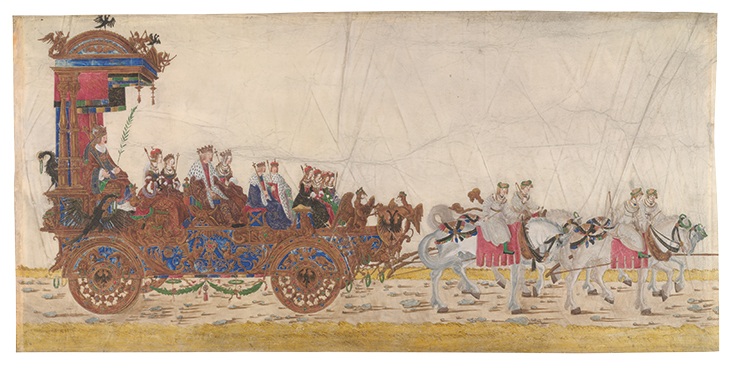
Triumphal Procession is, if anything, even more catholic in its scope. It was produced first in a spectacular watercolour-on-parchment version by Altdorfer in 1512–15. Subsequently, it was prepared for publication, with as many as seven artists – including Burgkmair, Altdorfer, Dürer, his pupil Hans Springinklee and Leonhard Beck – concocting woodcut designs, though the final version was not printed until seven years after Maximilian’s death. To the iconographic elements found in Arch of Honour were added trophies of war, armaments, animals and generic figures – knights and soldiers, hunters and musicians, servants and prisoners – half-real, half-imagined. In the woodcut version, the universalist vision of this enterprise is underscored by the inclusion of camels, elephants and peoples from the New World.
To deepen familiarisation with Maximilian and his marvels, images were constantly recycled across mediums. This was particularly true of the emperor’s own visage. The famous likeness of Maximilian in profile, with his trademark hooked nose and protruding chin, originated in a portrait painted by the German artist Bernhard Strigel in the 1490s, which soon became a template for countless other representations of him, not only in paintings but also in woodcuts, on coins and medals produced at the royal mint at Hall near Innsbruck and even on draughts pieces. This was branding, Habsburg style, with Maximilian revelling in his physical idiosyncrasies.

Artefacts received the same treatment. It was not enough, for instance, for Maximilian to flaunt his superb armour on the tournament grounds of the Low Countries and Germany. He also sought to immortalise it on the page, most notably in Freydal, with its thrilling depictions of one-to-one combat, woodcuts of which Dürer was working on when Maximilian died (only five were ever completed). In the same vein, a substantial section of Triumphal Procession was given over to displaying Maximilian’s richly decorated artillery, of which he was particularly proud, to the point that he gave names – Crocodile, Steinbock, Bumblebee – to individual cannons and mortars.
Maximilian took no chances when it came to ensuring that the message of his artworks would be understood. One of the distinguishing features of his commissions is the combination of image with word. This is most obvious in such printed works as Theuerdank, a verse epic purportedly written by Maximilian recalling in allegorical form his courtship of Mary of Burgundy, and Weisskunig, a romanticised biography of Maximilian. Only Theuerdank was published in Maximilian’s lifetime (in 1517), but in both cases the concept (inspired by the Heldenbücher of old) was the same: a long, printed text accompanied by plentiful woodcut illustrations principally by Burgkmair and Beck, each supporting the other. Maximilian justified this approach in the introduction to Weisskunig: ‘I have added painted figures to the text with which the reader with mouth and eye may understand the bases […] of my book.’ But it was not just narrative works that underwent this treatment. More conventional image-based works were also deemed in need of verbal elaboration. Coins, medals and painted and woodcut portraits were adorned with recitations of Maximilian’s titles, and allusions to ancient Rome (‘Imperator Caesar Maximilianus’).
There is little doubt that Maximilian personally superintended the most important of these projects, principally through Treitzsaurwein. A manuscript containing Treitzsaurwein’s notes of the instructions Maximilian gave him for Triumphal Procession survives. So too does a draft of another work, Historia Friderici et Maximiliani, in which Maximilian has crossed out two illustrations and added comments to others (including the unusually modest ‘better to have posthumous praise’). Perhaps to highlight his own artistic genius – another sine qua non of the perfect monarch – Maximilian had himself depicted directing these various enterprises. In Weisskunig, the emperor is shown standing behind an artist’s easel, pointing to the canvas he is painting. A drawing in one of Treitzsaurwein’s notebooks, meanwhile, shows the secretary on one knee in front of the imperial throne receiving dictation from Maximilian.
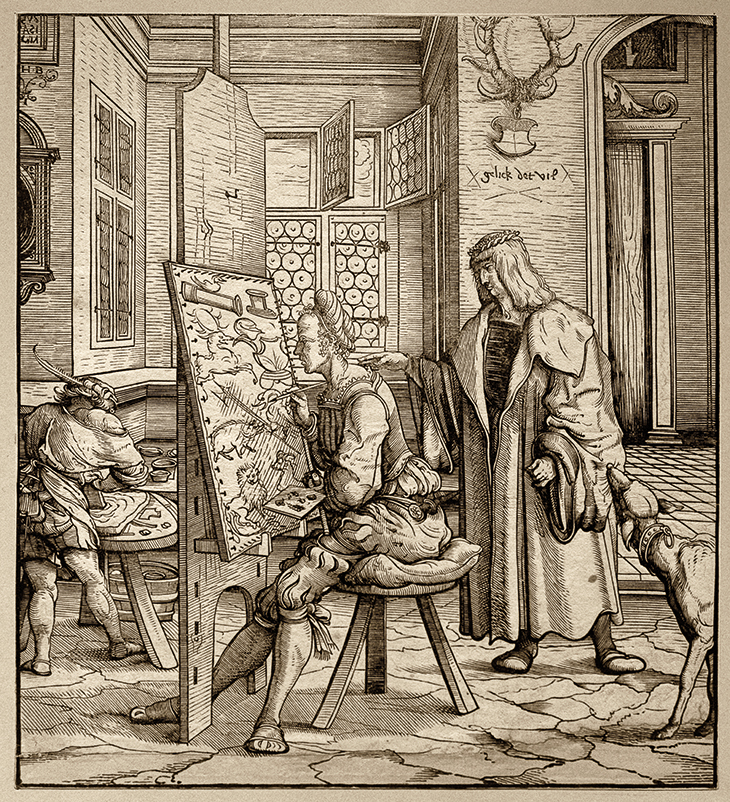
In spite of the close attention he gave them, few of the large-scale works Maximilian commissioned were completed in his lifetime. This category includes perhaps the most extravagant project of all, his cenotaph, which was to immortalise his reign. Its thematic components – heraldry, scenes of Maximilian’s marriages and victories, Roman emperors, knightly paladins, ancestral figures – were drawn from existing works. What was different was the plan to give them three-dimensional form through marble reliefs, bronze busts, oversized statues and smaller statuettes in a dedicated mausoleum with a vast tomb chest at its centre.
The scale of the work was far beyond any single person’s management. When Maximilian died in 1519 at the age of 59, numerous contractors were working on its various elements, including Dürer, who designed the dashing statue of King Arthur (one of only 11 to be finished in the emperor’s lifetime). For the next 60 years, the completed parts of the cenotaph hung around in storerooms, while the remaining elements were being completed. The marble reliefs chronicling Maximilian’s life were not executed until the 1560s, the majority (20 out of 24) being done by the Flemish sculptor Alexander Colin in the High Renaissance style, while the kneeling figure of the emperor on top of the sarcophagus was made even later. The ensemble, including 28 bronze statues of kings and queens forming a guard of honour around the sarcophagus, was finally installed in the Hofkirche in Innsbruck between 1572 and 1584. But Maximilian’s mortal remains never made it there from Wiener Neustadt, where initially he had been buried. Even in death, impressions trumped reality.
‘He who makes no memory of himself during his lifetime will have none after his death, and will be forgotten with the tolling of the final knell,’ Maximilian proclaimed, as though to vindicate this vast scheme. Yet the lengths to which his descendants, particularly his grandson Emperor Ferdinand I and great-grandson Archduke Ferdinand, went to complete the cenotaph and his other unfinished works belie this assertion. For all that they looked back to ancient Rome, to ancestral heroes and to Maximilian’s own youthful exploits, his works were memorials for the future, declaring that the Habsburgs deserved their dawning pre-eminence in the pantheon of European princes.
‘The Last Knight: The Art, Armor, and Ambition of Maximilian I’ is at the Metropolitan Museum of Art, New York, from 7 October until 5 January 2020.
From the September 2019 issue of Apollo. Preview the current issue and subscribe here.

